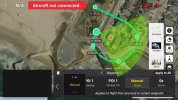Droning on and on...
Well-Known Member
Okay, I think I get what @jephoto is getting at. Check out this mockup... Is this the idea? the green translucent arc shows what will be in frame (not exact, 90° rather than 81 'cause the drawing app wanted to snap to common angles) for a level, 0° tilt gimbal.
This could easily be dynamic, narrowing the angle if zoom is employed (useful for video, not so much stills).
Another feature that actually would be pretty simple to add. Maybe we should suggest to DJI?

This could easily be dynamic, narrowing the angle if zoom is employed (useful for video, not so much stills).
Another feature that actually would be pretty simple to add. Maybe we should suggest to DJI?










